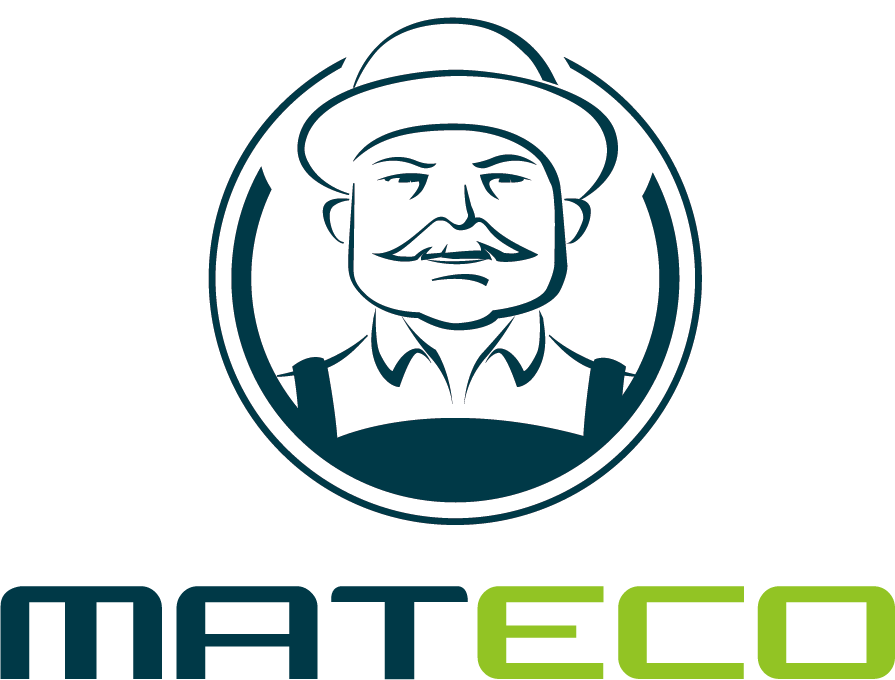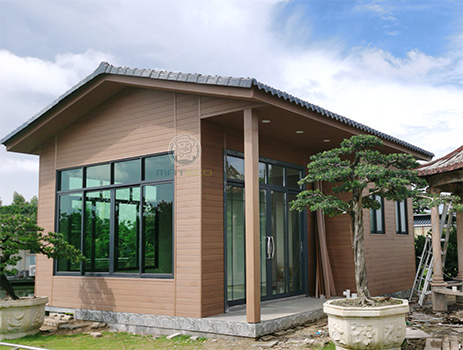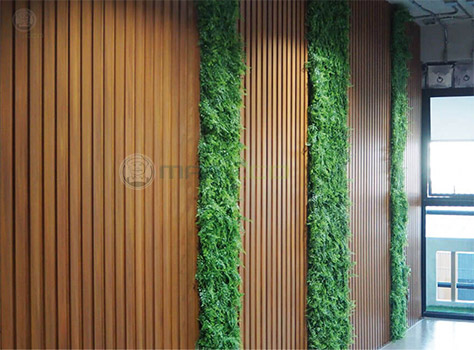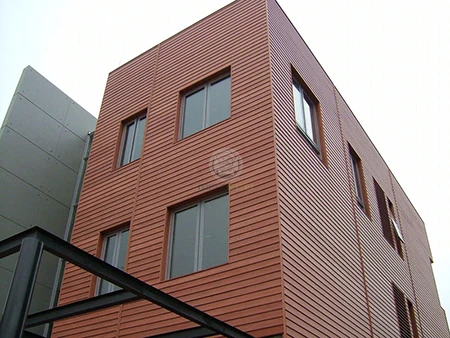Are WPC Panels Waterproof?
In the ever-evolving world of construction and design, one material has been making waves and capturing the imagination of architects, builders, and homeowners alike: Waterproof Exterior Wall Panels. But what sets these panels apart from the traditional choices, and can they live up to the promise of being truly waterproof?
Today, we're here to unveil the secrets of Waterproof Exterior Wall Panels, with a special focus on the remarkable Wood-Plastic Composite (WPC) panels. We'll dive deep into the science behind waterproofing, explore the myriad benefits they offer, and answer the burning question: Are WPC panels the ultimate solution for waterproofing your exterior walls?
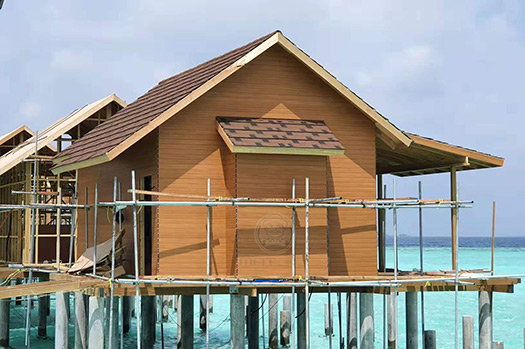
Wood plastic siding house on the sea
1. What Are Waterproof Exterior Wall Panels?
Waterproof exterior wall panels, also known as WPC (Wood-Plastic Composite) panels, are cutting-edge construction material designed to provide both aesthetics and protection. These panels are specifically engineered to resist moisture, making them ideal for exterior applications where traditional materials may succumb to water damage over time. Waterproof exterior wall panels are often used to enhance the appearance and durability of buildings, offering a visually appealing, low-maintenance alternative to wood, PVC, or other cladding materials.
2. What Are WPC Panels?
WPC panels are a type of composite material made from a combination of wood fibers or sawdust and thermoplastic resins, such as polyethylene, polypropylene, or PVC. This unique blend of organic and synthetic materials results in a product that mimics the appearance of wood while offering enhanced waterproof properties and increased durability. WPC panels are highly versatile and can be customized to achieve various textures, colors, and designs, making them a popular choice for architects and homeowners looking for both beauty and functionality in their exterior wall coverings.
3. The Science of Waterproofing
Waterproofing is a crucial aspect of construction and building design, particularly when it comes to exterior wall panels. The science behind waterproofing involves a comprehensive understanding of materials, engineering principles, and the intricacies of moisture intrusion. In the context of exterior wall panels, the primary goal of waterproofing is to create a robust barrier that effectively prevents the passage of water, moisture, and humidity from the exterior to the interior of a building. Understanding how this barrier is achieved is essential for evaluating the waterproofing capabilities of materials like Wood-Plastic Composite (WPC) panels.
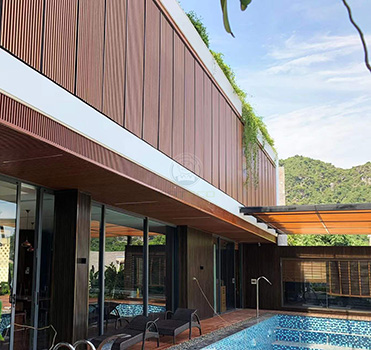
WPC outdoor wall covering for swimming pool
One of the key elements of the science of waterproofing is the selection of materials. In the case of WPC panels, these are composed of a blend of wood fibers or sawdust and thermoplastic resins. The choice of materials is critical, as it determines the panel's ability to resist moisture. Wood fibers provide a natural look and texture, while the thermoplastic resins add durability and waterproofing properties. The combination of these materials is engineered to create a synergistic effect that maximizes moisture resistance.
The science of waterproofing also encompasses the design and construction of the panels themselves. Engineers and manufacturers carefully consider the arrangement and composition of materials within the panel to minimize opportunities for moisture infiltration. This may include advanced sealing techniques, such as tongue-and-groove interlocking systems, to create tight, secure joints that effectively keep water at bay. The panel's surface may also be treated with coatings or laminates that enhance waterproofing while maintaining the desired aesthetic appearance.
Furthermore, understanding the behavior of moisture is essential in the science of waterproofing. Moisture can enter a building through various mechanisms, including rain, condensation, and capillary action. Waterproof exterior wall panels must be designed to counteract these mechanisms effectively. This may involve incorporating drainage systems that redirect water away from the panel's surface or the inclusion of vapor barriers to prevent moisture from migrating through the panel structure.
4. Maintenance and Longevity
Maintenance and longevity are two critical factors to consider when evaluating the suitability of exterior wall panels, including Wood-Plastic Composite (WPC) panels, for construction and design projects. Understanding how these panels fare in terms of upkeep and their expected lifespan is essential for making informed decisions about material selection.
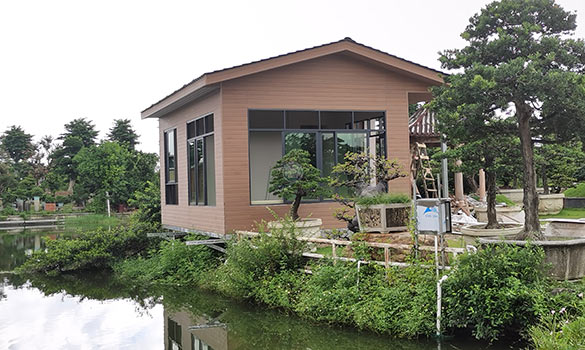
Waterproof exterior wall panels for the pond
One of the standout features of WPC panels is their low-maintenance nature. WPC panels demand significantly less attention than traditional materials like wood, which require regular painting, staining, and sealing to protect against moisture and decay. In most cases, routine maintenance for WPC panels involves simple cleaning with mild detergent and water to remove dirt and grime. This ease of maintenance makes them an attractive choice for homeowners and property managers looking to reduce the long-term maintenance costs associated with building exteriors.
The longevity of exterior wall panels is closely tied to their ability to resist moisture, decay, and environmental factors. WPC panels excel in this regard due to their inherent waterproofing properties. By effectively preventing water penetration, WPC panels reduce the risk of rot, mold growth, and other moisture-related issues that can significantly shorten the lifespan of traditional materials. As a result, WPC panels are often engineered to have a long service life, making them a durable and reliable choice for exterior cladding.
Furthermore, WPC panels are designed to withstand the rigors of the environment. They are engineered to resist UV radiation, which can cause fading and degradation in some materials. This UV resistance helps maintain the panels' color and appearance over time, reducing the need for repainting or refinishing. Additionally, WPC panels are less susceptible to warping, cracking, or splintering when exposed to temperature fluctuations, which can be common in various climates.
Another factor contributing to the longevity of WPC panels is their resistance to insect damage. Unlike wood, which is susceptible to termites and other wood-boring pests, WPC panels are unappealing to insects and do not provide a food source. This natural resistance helps ensure that the panels remain structurally sound and free from insect-related damage.
When considering the long-term performance of WPC panels, it's essential to choose a reputable manufacturer that adheres to industry standards and quality control measures. Proper installation by experienced professionals also plays a crucial role in maximizing the panels' longevity. Following manufacturer-recommended installation practices and maintaining proper flashing and sealing around joints and openings further enhances the panels' ability to keep moisture out and maintain their performance over time. MATECO WPC will be your ideal choice.
If you are looking for a WPC manufacturer, MATECO WPC will be your best choice.
Website: https://www.matecowpc.com
WhatsApp: +86-13380085620
Email: info@matecowpc.com
